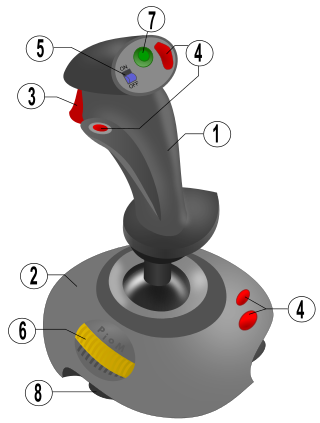
A joystick, sometimes called a flight stick, is an input device consisting of a stick that pivots on a base and reports its angle or direction to the device it is controlling. A joystick, also known as the control column, is the principal control device in the cockpit of many civilian and military aircraft, either as a centre stick or side-stick. It has various switches to control functions of the aircraft controlled by the Pilot and First Officer of the flight.
2.5D perspective refers to gameplay or movement in a video game or virtual reality environment that is restricted to a two-dimensional (2D) plane with little or no access to a third dimension in a space that otherwise appears to be three-dimensional and is often simulated and rendered in a 3D digital environment.
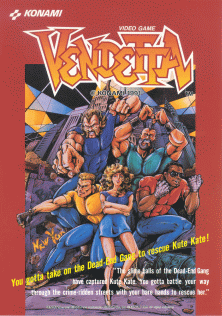
Vendetta, known in Japan as Crime Fighters 2 (クライムファイターズ2), is a 1991 side-scrolling beat-'em-up arcade game developed and published by Konami. It is the sequel to 1989 Konami's Crime Fighters, although it was marketed internationally as a stand-alone game with no previous connections.

Operation Thunderbolt is a light gun shooter video game developed by Taito and released for arcades in 1988. As the sequel to Operation Wolf, changes include two-player gameplay with two positional gun controllers mounted on the arcade cabinet, and a new forward-scrolling pseudo-3D perspective combined with side-scrolling sections.
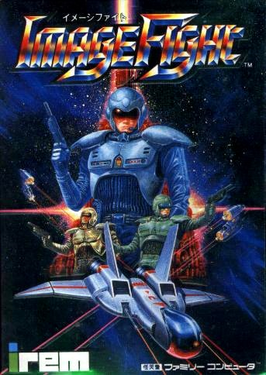
Image Fight is a 1988 vertically scrolling shooter arcade video game developed and published by Irem. It was ported to the Nintendo Entertainment System, PC Engine (Japan-only), Sharp X68000 (Japan-only), and FM Towns (Japan-only) in 1990.

U.N. Squadron is a 1989 side-scrolling shooting game released by Capcom for the CPS arcade hardware and for the Super Nintendo Entertainment System. The game was released in Japan as Area 88, and is based on the manga series of the same name, featuring the same main characters. Their mission is to stop a terrorist group known as Project 4. It was followed by a spiritual successor Carrier Air Wing.

Spider-Man: The Video Game, also known as Spider-Man, is a 1991 arcade video game developed by Sega based on the Marvel Comics character Spider-Man.
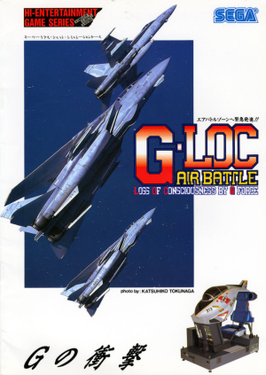
G-LOC: Air Battle is a 1990 combat flight simulator arcade video game developed and published by Sega. It is a spin-off of the company's After Burner series. The title refers to "G-force induced Loss Of Consciousness". The game is known for its use of the R360 motion simulator arcade cabinet. The arcade game was a commercial and critical success upon release.

Red Baron is an arcade video game developed by Atari, Inc. and released in 1981. A first-person flight simulator game, the player takes the role of a World War I ace in a biplane fighting on the side of the Allies. The game is named after the nickname of Manfred von Richthofen, German flying ace. The game uses the same monochrome vector graphics and similar hardware as Atari's own Battlezone; both were developed at the same time. Like Battlezone, the player is presented with a first-person view of the action. Both Battlezone and Red Baron use additional hardware, an "Auxiliary" board, to perform the mathematical computations required for simulating a 3D environment.
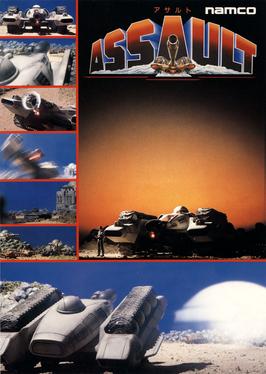
Assault is a 1988 multi-directional shooter arcade game developed and published by Namco. It was licensed to Atari Games for release in North America. Controlling a caterpillar-tread self-propelled gun, the player is tasked with completing each of the game's eleven stages while shooting enemies and avoiding projectiles. It uses a twin-stick control layout, similar to games such as Battlezone. The plot involves the human race searching for new planets after Earth reaches its maximum population - after discovering an exo-planet 35,000 light years away from the Milky Way, they enslave the planet's natives and take control, leading to the planet's native population vowing to abolish the humans and bring peace to their world. The protagonist who rides the aforementioned self-propelled gun which players control, is one such native.

Super Xevious is a vertically scrolling shooter released as an arcade video game in Japan in 1984. It was developed and published by Namco as an updated version of Xevious (1982) created as a response to the overwhelming success of the original in Japan. It was sold as conversion kit for existing Xevious cabinets.
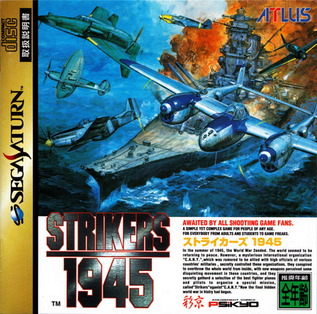
Strikers 1945 (ストライカーズ1945), also known as Striker 1945, is a vertically scrolling shoot 'em up arcade game developed and published by Psikyo in 1995. In Japan, it was ported to the PlayStation and Sega Saturn by Atlus in 1996; later was also released as part of Psikyo Shooting Collection Vol. 1: Strikers 1945 I & II by Taito for the PlayStation 2. The game was followed by Strikers 1945 II in 1997, and Strikers 1945 III in 1999, as well as the second title remake called Strikers 1945 Plus.

Sky Mission is a 1992 combat flight simulation video game developed by Malibu Interactive and published by Namco for the Super Nintendo Entertainment System. In North America, the game was rebranded as the sequel to the Commodore Amiga game Wings, titled Wings 2: Aces High, while in Europe it was renamed to Blazing Skies. As the leader of a British plane squadron during World War I, the player is tasked with destroying enemy planes under the command of German emperor Kaiser Wilhelm II in France. Gameplay involves gunning down enemies and performing bombing runs on enemy bases. The game was produced by Ken Lobb, best known as the co-creator of the Killer Instinct fighting game series, with music composed by musician George Sanger. Sky Mission was met with a mixed reaction from critics — although it was disliked for its short length and lacking gameplay, it was praised for its realistic visuals, soundtrack and sense of thrill.

Time Pilot '84: Further Into Unknown World is a scrolling multidirectional shooter released in arcades in 1984 by Konami. The different time periods of 1982's Time Pilot are replaced by a top-down view of a science fiction landscape that varies in color and type of enemies. It adds the ability for the player to launch guided missiles. Time Pilot '84 was primarily sold as a conversion kit for older games.

B-Wings is a vertically scrolling shooter first released as an arcade video game by Data East in 1984. A version was released in 1986 for the Family Computer. It was Data East's very first home release for the console. The Family Computer version is notable for its inclusion in many unofficial Famiclone multicarts.

Superman is a 1989 arcade action game released by Taito and featuring the DC Comics character Superman. While not directly based on the original film series, throughout much of the game the "Superman Main Theme" and "Can You Read My Mind" from the Superman films are used as background music.

Varth: Operation Thunderstorm is an arcade game in the vertical scrolling shooter genre, published by Capcom in 1992. The game did not see a console port following its initial release, but 14 years later Digital Eclipse Software would port the game onto the PSP handheld, and later onto the PlayStation 2 and Xbox.

Red Alert, also known as WW III, is a fixed shooter developed by Irem and released in arcades in July 1981.

Pursuit is a single-player arcade video game by Kee Games, originally released in 1975. The player plays a World War I flying ace who tries to shoot down enemy planes. Gameplay is from a first person perspective. Pursuit marks the first time Atari Inc. publicly acknowledged its relationship with Kee.
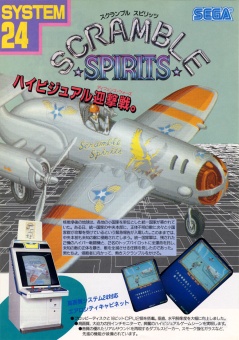
Scramble Spirits is a vertically scrolling shooter game released for the arcades by Sega in 1988. It was ported to the Master System the same year, then to personal computers in 1990.


















